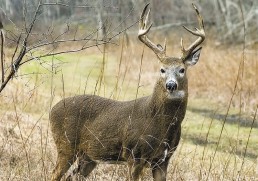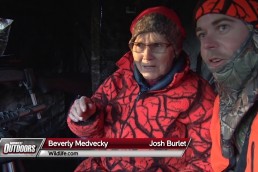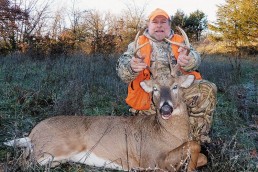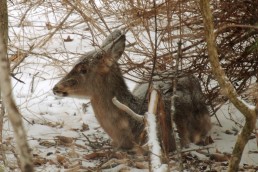2015 Michigan Deer Hunting Prospects
SHARE THIS POST
No amount of hunting guarantees a harvest, but preparation and hard work increase your chances to see and take deer, or to mentor a new hunter through a safe and enjoyable season. The 2015 Michigan deer season is expected to be good, with challenges and rewards for those who venture afield.
Stick with it
Nationwide, successful deer hunters hunt an average of 18 days––slightly more than the average of about 14 days that Michigan deer hunters spent afield last year. Your hunting preparation should include becoming familiar with the most recent regulations. The deer website of the Michigan DNR (michigan.gov/deer) provides highlights of regulations changes, information about deer management, and links to additional resources, such as a list of deer check stations. Also, refer to The 2015 Hunting and Trapping Digest and Antlerless Digest, available in PDF form at the website, or at DNR Operations Service Centers, licensed vendors.
Deer activity tends to be highest a few weeks prior to breeding, with the peak occurring just prior to the opening of the firearm deer season. These peak breeding dates are earliest in the southern Lower Peninsula, except that many does in the region that were born this past spring will already conceive their first fawns this year. Those breeding events for young does often occur a month or more later than for older deer, in about mid-December. Hunters often seek to take advantage of these high deer movements, so archery hunting often peaks in late October and early November, followed by the busiest deer hunting day of the year—the opening of the firearm season. In southern Michigan, another late period of deer activity can occur several weeks prior to the late breeding events among young does, which can coincide with the end of the firearm season.
What to expect across the state
The 2014 season saw a drop in deer harvest in the majority of Midwestern states, and Michigan was no exception. Hunting success decreased somewhat across the state; though a little more than 5 out of every 10 hunters were able to take home at least one deer. The decrease in harvest occurred across the entire state, but was most pronounced in the Upper Peninsula. The Upper Peninsula experienced severe and prolonged winters in 2012 and 2013, and deer harvest was expected to decline as a result. Both the Upper Peninsula and Northern Lower Peninsula experienced high snowfall just prior to the firearms deer opener, which made for difficult hunting conditions across much of northern Michigan. Areas in the Southern Lower Peninsula were still recovering from the Epizootic Hemorrhagic Disease outbreak that occurred in the summer of 2012 as well.
The winter of 2014 started early and continued into spring throughout most of the state, leading to another harsh winter in many northern areas. Low temperatures and above average snowfall made for difficult conditions for deer, most notably in the Upper Peninsula for the third winter in a row. Some areas may see decreased numbers of yearlings as a result, but overall, there appears to be good survival throughout much of the lower Peninsula regions.
The 2015 deer season is forecast to have similar to slightly increased success rates. Please see below for more detailed information about the area you hunt and what to expect. Though this might help you get started with what to look for, there is no substitute for scouting. The opportunity to find out which trees are producing, what deer trails are being used and what patterns deer are following this year is priceless information for a deer hunter. So, whether your goal is to get meat in the freezer, go for a wall hanger or simply get outdoors, Michigan’s deer seasons offer something for everyone. Best of luck to you, and have a wonderful and safe deer season.
Upper Peninsula
The Upper Peninsula (UP) has experienced three severe winters in a row. This has led to decreased deer numbers throughout the region with losses occurring most notably in the 1.5 and 2.5 year old age classes. In 2014, as part of the first cycle of multiple year deer regulations, biologists recommended closing all public land and all but three private land deer management units for antlerless licenses in order to allow deer numbers to rebound. The three units currently open for private land antlerless licenses are located in the south central portion of the UP which typically has higher deer populations than anywhere else in the UP. Antlerless permits are available in Deer Management Units: 055 (Menominee), 122 (Norway), and 155 (Gladstone).
New for 2015: concern for the deer herd has remained high after 2014 proved to be another severe winter for the UP. Therefore, the decision was made by the Natural Resources Commission to no longer allow the harvest of antlerless deer with either the single deer license or a combination deer license during the archery season. Archery hunters may only harvest antlerless deer if they have an antlerless license. This change does not affect the Liberty or Independence Hunt and does not impact Mentored Youth.
The production of mast (fruit and nuts) in the UP has been low throughout much of the region this year. There is some acorn and beechnut production but it is spotty throughout the region. Hunters need to scout in order to find these areas. Although mast production was low this year, there was enough heat and rain toward the end of the summer to have a productive growing season, giving deer many other food sources to seek out.
Are you enjoying this post?
You can be among the first to get the latest info on where to go, what to use and how to use it!
In general, hunters should expect to see fewer deer, especially in the 1.5- and 2.5-year-old age classes. Always keep in mind that each area is influenced by local factors and conditions that affect deer density and sightings in that area. The largest bucks (heaviest and largest antlers) typically come from agricultural areas, but nice bucks are also taken from forested areas where access is limited and they have an opportunity to get older.
Northern Lower Peninsula
The deer population in the Northern Lower Peninsula (NLP) is expected to be on the increase in comparison to last year. Even with the severe winter this past year, deer in the NLP came through it in fair to good condition.
Deer sightings have been good throughout the region and many have reported seeing healthy fawns, including many sets of twins and even some triplets. Though it appears some deer might have been lost, the main impacts observed from the severe winter will likely be smaller body size and/or antlers rather than lower populations.
Mast production (fruits and nuts) has been spotty throughout the region. For the second year in a row high production of apples are being reported. Acorn and beechnut production is diverse with some areas seeing decent production and others reporting none. Deer should be targeting the producing areas frequently. Scouting to find these areas will be very important. Contacting your local wildlife office may be a good first step; they may be able to give you insight as to which areas are producing.
Expect to see similar to increased deer numbers compared to last year throughout most of the NLP. Many areas might see more 2.5-year-old bucks this year as well, because a number of NLP counties began a 3-point antler point restriction in 2013. That allowed the majority of 1.5-year-old bucks to mature to the next age class. All NLP Deer Management Units are open for antlerless hunting, so be sure to look in the 2015 Antlerless Deer Digest if you are interested in obtaining an antlerless license.
Southern Lower Peninsula
Abundant food and cover in the form of agricultural crops and scattered swamps and woodlots provide very good habitat across the southern Michigan landscape. This high quality habitat, combined with relatively mild winter conditions, typically results in a more abundant and productive deer population compared to other regions of the state.
Over the last decade or more, deer population estimates and indices (including deer/vehicle collisions, crop damage complaints, and observations of deer by the hunting community and field staff) in the Southern Lower Peninsula have stabilized or declined. In many instances, reductions were intended to reduce conflicts that can occur when deer populations are high, though the Department still desires to keep adequate deer for enjoyable hunting and viewing experiences. Repeated outbreaks of Epizootic Hemorrhagic Disease (EHD), however, have also occurred over this period. Though individual EHD outbreak sites affect deer at the scale of a township or smaller, these outbreaks have likely produced more variability in deer densities across southern Michigan than has occurred in many years. Management efforts are now being directed towards distinct areas at a smaller scale rather than larger. Research is underway to improve understanding of the duration of EHD impacts that hunters and landowners should expect to see where outbreaks have occurred. Given the higher proportion of land in private ownership in this region, and the often small property sizes, the Department is working to find more ways to support good deer harvest and habitat management decisions among networks of private landowners and hunters.
Chad Stewart is a Deer and Elk Program Specialist at Rose Lake Wildlife Research Center in East Lansing, Michigan. Ashley Autenrieth is Northern Regions Deer Biologist at the Gaylord Operations Service Center. Both work for Michigan DNR.
MWO
SHARE THIS POST
Did you enjoy this post?
You can be among the first to get the latest info on where to go, what to use and how to use it!
Ashley Autenrieth
MidWest Outdoors works with more than 200 outdoor experts each year, who contribute articles based on their areas of expertise. MidWest Outdoors magazine offers more fishing and hunting articles than any other publication!




